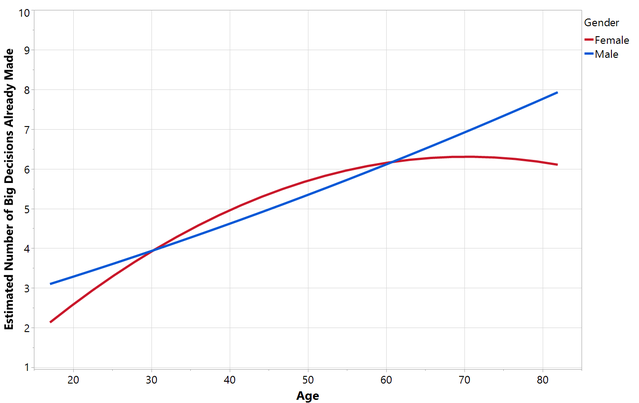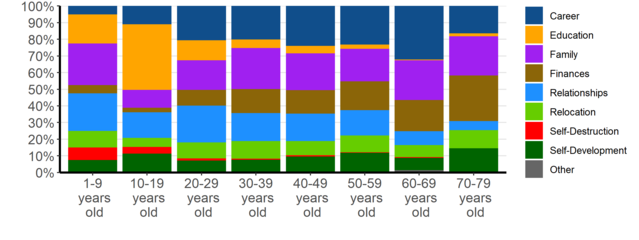Career
When Do Life's Biggest Decisions Happen?
New research reveals when the biggest life decisions happen.
Posted February 7, 2021
Most people can expect to live beyond 75 years of age. During this time, you will make tens if not hundreds of thousands of decisions. But only a handful of these decisions will have a significant and long-term impact on your life. These are the big decisions.
I have spent my career studying decisions. A couple of years ago, I began to ask people to tell me about their biggest life decisions. In this post, I share what I have learned.
The question we’ll consider in this post is when do these big life decisions happen? Are they evenly distributed across the decades or do they clump in particularly important periods of life? And do different types of big decisions tend to happen during certain periods of life?

Life's biggest decisions
The most common big life decisions are no surprise: What to study? Where to work? Where to live? Whether to buy a home? Whether to get married? Whether to have children?
As I have described in a previous post, big life decisions can be placed into one of the following categories: career, education, family, finances, relationships, relocation, self-destruction, self-development, and other. Each of these has a number of sub-categories.
How many big life decisions have you made?
One of the most interesting questions people were asked in the survey was how many of their life’s ten biggest decisions they thought they had already made. The results are presented in the chart below split by gender.

What you can see is that the average 20-year-old estimates that they have already made 3 of their 10 biggest life decisions. Each subsequent decade of age is associated with slightly less than one additional big life decision. Those aged around 44 years estimate that half of their 10 biggest life decisions have already been made. Perhaps most interestingly, the average 75-year-old still estimates they have a few big decisions left ahead of them.
There are also some interesting gender differences. Males display a linear relationship between time and the number of big decisions. Basically, men who are older estimate that more of their big life decisions have been made. The same relation exists for females but only until the age of 60. Beyond this point, the relation breaks down with women over the age of 60 still expecting at least three more big life decisions. This may have something to do with the longer life expectancy for females.
What types of big life decisions happen when?
Let’s now turn to the types of big decisions that are being made. The chart below shows people’s approximate age at the time they made different types of decisions. There are a few things that jump out.

During the pre-teen and teen years, the biggest life decisions often relate to education as students choose high-schools and colleges and majors. This is also the most common age for self-destructive decisions, such as starting an addiction, as young adults explore their identity.
Upon graduating, career-related decisions become important as people take and quit jobs and start and close businesses. Career-related decisions actually grow in importance over time until the decision is made to retire.
For the first few decades of adulthood, relationship-related decisions are important. These decisions include forming and ending romantic and non-romantic relationships. Eventually, as people settle down, family-related decisions become more important. These include decisions of having and then caring for children. Later in life, these decisions include caring for other family members such as grandchildren and now elderly spouses.
Financial-related decisions increase over time. This is likely because, as wealth, assets, and investments accumulate, more and more decisions must be made about managing and eventually dispersing those things.
In later years, particularly after retirement, more self-developmental decisions come to the fore. These include corrective decisions, such as quitting an addiction, as well as more fulfilling decisions, such as engaging in a new hobby.
Take-homes
There are a few important take-homes from this analysis. First, big life decisions are front-loaded. You are most likely to make a big life decision between ages 16 and 35. These are busy times as many people get an education, pursue a career, put down roots, and start to build a family.
Second, although somewhat front-loaded, big decisions occur throughout one’s life. You may think at age 30—with a degree, job, home, spouse, and child on the way—that you’ve already made most of your big life decisions. You’re probably wrong. Life has a way of constantly throwing curveballs. In your future, there may be post-graduate degrees, career changes, renovations, re-marriage, and even more kids.
Third, different types of decisions are more likely to occur during different periods of your life. Education-related decisions dominate early and are replaced with career-related decisions. Family and financial-related decisions increase over time.
Finally, no matter how old you are, there always seem to be big life decisions lurking around the corner. And there usually are. As a 20- or 30-something-year-old, it’s very difficult to contemplate making decisions about retirement, or for your grandchildren, or letting go of a loved one. However, the experience from those who have been there before serves as a lesson for us all.
The next post in this series is “How to Make a Good Big Life Decision?” In the meantime, if you'd like to see how your own big decisions compare to others, complete the survey yourself here and also check out the data.




